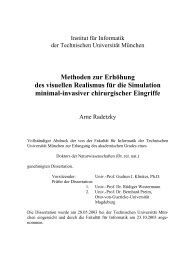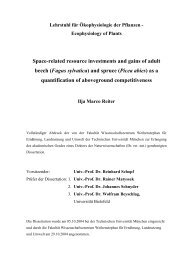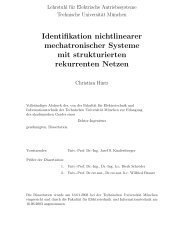Topologically Defined Neuronal Networks Controlled by Silicon Chips
Topologically Defined Neuronal Networks Controlled by Silicon Chips
Topologically Defined Neuronal Networks Controlled by Silicon Chips
Create successful ePaper yourself
Turn your PDF publications into a flip-book with our unique Google optimized e-Paper software.
CHAPTER 2. NETWORKS OF DEFINED TOPOGRAPHY<br />
Figure 2.11: Detailed model of two electrically coupled neurons. In the equivalent circuit the connecting<br />
neurites are described <strong>by</strong> the cable equation. Neuron A is always presynaptic.<br />
voltages at the tips of the pre and postsynaptic neurite, V (LA0) and V (LB0), according to (the index<br />
A0 denotes the 0th neurite of neuron A):<br />
Gsyn =<br />
Isyn<br />
V (LA0) − V (LB0)<br />
(2.29)<br />
These quantities are not directly accessible experimentally, but they can be calculated from the somatic<br />
voltages and the injected current with the cable equation, if the electrical parameters of the neurites are<br />
known. From a current balance similar to equations 2.20 - 2.23, but with the neurite properties included,<br />
an expression for the exact synaptic conductivity G cable<br />
syn was derived, based on the value obtained with<br />
the simplified model Gsyn (remember Lj = lj/λj) [82].<br />
1<br />
G cable<br />
syn<br />
= 1<br />
Gsyn<br />
1<br />
cosh LA0 cosh LB0<br />
− λA0RA0 tanh LA0 − λB0RB0 tanh LB0<br />
(2.30)<br />
Neglecting the neurites completely <strong>by</strong> setting Lj = 0 leads to G cable<br />
syn = Gsyn as expected. For electrotonically<br />
short neurites with LA0 ≪ 1 and LB0 ≪ 1 equation 2.30 is reduced to:<br />
1<br />
G cable<br />
syn<br />
= 1<br />
− RA0lA0 − RB0lB0<br />
Gsyn<br />
Only the series resistance of the synapse and the neurites matter in this approximation.<br />
(2.31)<br />
As mentioned in subsection 2.4.1, neurites from Lymnaea stagnalis growing on patterned substrates<br />
are electrotonically compact, i.e. their influence on propagating signals is small. Therefore, the error<br />
from calculating Gsyn instead of G cable<br />
syn is moderate if the coupled neurons are close to each other, with<br />
short connecting neurites, and if Gsyn is small. With increasing synaptic conductivity, the synaptic<br />
current rises, causing a bigger voltage drop in the neuritic cables that must be taken into account. The<br />
last requirement is also obvious from eq. 2.31. The smaller Gsyn, the smaller the impact of the terms<br />
Rjlj on the fraction. Experimental data show that these conditions are met for networks of Lymnaea<br />
neurons. The average deviation between G cable<br />
syn and Gsyn was just 13% for 11 pairs in [82] and 20%<br />
for the experiments here, see subsection 2.5.4. This is also confirmed <strong>by</strong> model calculations, showing<br />
that cable effects can be omitted if the overall neuritic length doesn’t exceed approximately 500µm and<br />
if Gsyn
















